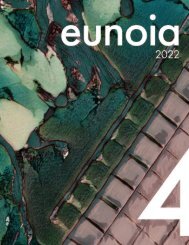WSU EUNOIA Volume III
You also want an ePaper? Increase the reach of your titles
YUMPU automatically turns print PDFs into web optimized ePapers that Google loves.
THE ETHICAL AND EXISTENTIAL
MEANING OF BEAUTY
JUHANI PALLASMAA
ARCHITECT, PROFESSOR EMERITUS (AALTO UNIVERSITY), WRITER
Figure 1: “If a work only expresses the person
who created it, it wasn’t worth doing [...]
Expressing the world, understanding it, that is
what seems interesting to me.””Great painting
has to have universal meaning. This is no longer
so today and that is why I want to give painting
back its lost universality and anonymity,
because the more anonymous a painting is, the
more real it is.” -Balthus (Balthazar Klossowsky
de Rola)
March 7, 2022 was about to
become a memorable day for the
students at the School of Design +
Construction. The largest crowd
in the school’s lecture series that
year were gathered online to hear
from Juhani Pallasmaa—a globally
celebrated architect, educator,
theorist, and critic who was joining
from Helsinki, Finland. However,
the connection failed. As the chair
of the school’s lecture committee, I
felt great disappointment for letting
our guest speaker, and the great
audience, down not realizing that
some technical issue cannot prevent
the dissemination of beauty. In a
generous gesture, Juhani offered
his “Ethical and Existential Meaning
of Beauty” to be published in
Eunoia. “Reading about all the
people who had connected to
hear the lecture,” Juhani wrote to
me, “I feel frustrated. [...] As an
alternative, you could publish it, as
it is a manifesto for a more inclusive
and biologically oriented thinking
about architecture.” Reading his
words, I wondered if this act of
kindness and generosity is not the
existential meaning of beauty, I
don’t know what is.
Juhani Pallasmaa is the former
dean at the Helsinki University of
Technology and former Director of
the Museum of Finnish Architecture.
His projects have been globally
recognized through awards, such
as the Arnold W. Brunner Prize
from the American Academy of Arts
and Letters, the Fritz Schumacher
Prize, the Schelling Architecture
Theory Prize, and the Finnish State
Architecture Award. Pallasmaa
was Finland’s representative at
the Venice Biennale in 1991, and
for 5 years (from 2009 to 2014)
served as a jury member for the
Pritzker prize. Pallasmaa is one of
world’s most respected architectphilosophers,
that aside from a vast
number of architectural projects
around the globe, has authored
more than 70 edited or penned
books and 950 published essays,
articles, and prefaces, translated
into 37 languages. His “eyes of
the skin” is considered a classic
polemic on spatial experience,
which continues to have a major
impact on phenomenological
discussions of architecture. In
his writings, including this text,
Pallasmaa brings together
discussions from phenomenology,
ethics, psychology, aesthetics, art,
and cinema. -Vahid Vahdat
BEAUTY, AESTHETICISATION,
AND NEWNESS
Beauty and ethics, as well as
Art is realistic when it strives to express an ethical idea.
Realism is striving for the truth, and truth, and truth is
beautiful. Here aesthetic coincides with the ethical. 1
-Andrey Tarkovski
their hidden relationships, are no
doubt, unfashionable subjects in
today’s artistic and architectural
discourse. In the era that reveres
appealing images and formal
inventions, the ethical perspective
has been pushed aside and the
ethical dimension has rarely
entered recent writings on art
and architecture. The Ethical
Function of Architecture (1996),
by philosopher Karsten Harries, is
a rare example in our time of the
interest in the ethical dimension of
architecture. 3 Artistic quality is
generally seen as a subjective and
unique expression, and instead of
suggesting an ethical resonance,
it is expected to exhibit unforeseen
imagery. In fact, beauty and ethics
have been problematic concepts in
the arts for a century and a half,
and artists have usually questioned
or neglected these notions.
In our obsessive consumerist
culture, beauty has turned into a
deliberate aesthetic manipulation
and seduction; everything
from products to environments,
personality to behavior, and politics
to war, is now manipulatively
aestheticized. We have entered
the era of “aesthetic capitalism”,
in accordance with the title of a
recent book by Gernot Bohme,
the German philosopher, who has
also pioneered in the philosophical
analysis of atmospheres. 4 This
new mode of capitalism implies a
distinct calculated manipulation
of appearances and the loss
of sincerity. Besides, today’s
formalist and rhetorically
dramatized architecture hardly
aspires for beauty and serenity,
as experiences of the unforeseen,
stunning, and the unheimlich, or
of outright imbalance and threat,
are frequently more apparent in its
imagery.
During the modern era, the
requirement for beauty has
been replaced by the obsession
with newness. Paradoxically
however, even newness turns
into repetitiousness. “As the new
is searched only because of its
newness”, as the Norwegian
philosopher Lars Svendsen
(1970-) points out in his book,
The Philosophy of Boredom. 5
However, beauty is always
connected with timelessness
as it turns our consciousness to
permanence and eternity. “The
language of beauty is essentially
the language of timeless reality”,
philosopher Karsten Harries
(1937-) claims. 6 “Beauty connects
us with the eternal”, as Jorge Luis
Borges formulated this thought. 7
What is the meaning of this forceful
distancing of art and architecture
from beauty, ethics and life? In
this book, The Dehumanization
of Art and Other Essays of Art,
Culture and Literature (1925),
Jose Ortega Gasset (1883-1955)
suggests that the subject matter
of art has gradually shifted from
“things” to “sensations”, and
finally, to “ideas”. 8 In Ortega’s
view, this development has
gradually weakened the human
content in art. Regardless of
whether we agree with Ortega’s
analysis or not, it opens a
thought-provoking view into the
transformation of the essence of
art. This is a shift from concrete
“
8 9
volume iii
eunoia





